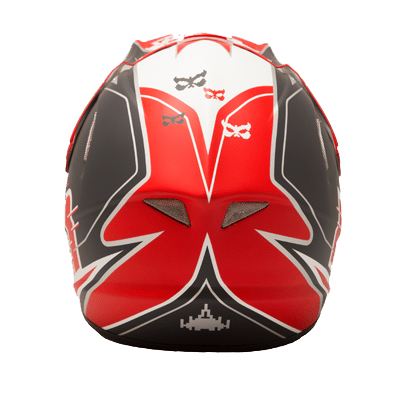
Kali Avatar X Helmet
Size: Medium (57-58cm)
Color: Black / Red
Blister’s Measured Weight: 876 grams
Features:
- COMPOSITE FUSION™ PLUS technology
- Integrated Airflow System
- Low density CONTEGO EPS foam for impact absorption
- TRI-WEAVE shell featuring KEVLAR, carbon fiber and fiberglass materials
- Washable, adjustable, anti-microbial fit pads
- Breakaway visor
Price: $300
Duration of Test: a month
Test Location: Whitefish, MT; Fernie, BC; Kellogg, ID
Reviewer: 5’9” 155 lbs
Head circumference: 57 cm
The big news from Kali this season is the introduction of the Shiva, a helmet that incorporates some new technology to make it smaller, lighter, and (reportedly) safer. But with that new technology comes a price tag ($500) that will likely put the Shiva out of reach for a lot of riders.
Fortunately, Kali also offers a few helmets at a lower price point that still do a bang-up job of protecting your head.
The Avatar line of helmets have been a staple of Kali’s product range for a while, and the Avatar X falls right in the middle. (The Savara is a less expensive option, and the Avatar II comes in a notch above.)
The Fit
I’ll start this off the same way I start every helmet review, with fit. A good helmet fit is vital, and a sloppy helmet fit significantly reduces a helmet’s ability to protect you in a fall (not to mention that it’s annoying when your helmet is banging around on your head). It doesn’t matter if a helmet has the greatest features in the world at a great price—if it doesn’t fit right, none of that does you any good.

For reference, my head is more on the oval end of the spectrum, and I have a fairly thin face. In the world of half-shells, this means that I usually fit in Giro helmets pretty well, and Bell helmets don’t fit me at all. For full faces, my prior lid was a POC Cortex, which fit me pretty well. I also fit well into a Troy Lee D3. 661 full faces are a little loose on me. (I’m referring to how a size Medium fits in all of these helmets.)
The fit of the Avatar X works for me, but it’s a smidge on the loose side. The shell is a little rounder than is probably ideal for my head shape, and the cheek pads could be a bit thicker to really keep the helmet stable on my head. That said, the fit certainly isn’t so loose that the helmet bobbles around on my head while riding.

I think Kali’s stated measurements on the helmet are true to size, and I think those who have a slightly rounder head and a wider face will do really well in the Avatar X.
On the comfort side of things, I found the Avatar X to do just fine. I never had any weird pressure points, and the lining inside the helmet didn’t rub me the wrong way. I can comfortably wear it for a full day of downhilling without any issues.
Construction / Safety
The Avatar X passes a slew of safety certifications: ASTM F1952, ASTM F2032, EN 1078, and CPSC.
Each of those standards has slightly different testing criteria, and the reason there’s a bunch of them is because different countries (and their legal systems) have developed and adopted different procedures.
Generally speaking, the helmet tests consist of putting the helmet on a weighted “head” and dropping it onto anvils of various shapes.
Notably, the ASTM F1952 certification is specifically designed for downhill bike helmets, and it’s testing criteria are more rigorous than many of the other test that bike helmets are regularly subjected to. (For the ASTM F1952 cert, helmets are dropped from larger heights, and it tests the chinbar, which most other certifications don’t.)
While certifications don’t mean everything, the Avatar X passes the normal certifications that one would expect of a DH helmet.
The shell of the Avatar X is made out of what Kali calls “Composite Fusion Plus technology,” which means that it has some funky stuff going on under the shell that isn’t immediately obvious just by looking at it.

But before getting into what the composite fusion plus moniker means, it’s important to understand the basics of a full face helmet.
For the vast majority of fully’s out there, the helmet is basically comprised of a relatively thin, stiff outer shell (usually fiberglass, or on higher end models, carbon fiber), with a thicker foam inner layer (usually expanded polystyrene foam or some variant thereof).
The foam inner layer is the part of the helmet that does most of the work in a crash—that’s the stuff that makes up most half-shell helmets on the market, and it’s designed to break when it smashes into something.
The basic premise behind all of that, and the goal of every helmet out there, is to simply dissipate energy. So when your head hits the ground, that abrupt shock is dissipated a little bit, and the rate of deceleration of your brain is prolonged by a fraction of a second. Hopefully, that tiny bit of extra time is enough to prevent (or at least minimize) the damage that comes from your brain sloshing around inside your skull.
So, back to composite fusion plus technology. Basically, Kali is doing two things here.
First, they’re making sure that polystyrene layer fits snugly up against the stiffer shell material. Making sure there’s no gaps helps to ensure that the helmet can properly do its job in a crash. They’re doing this by actually molding the foam in the helmet shell, rather than manufacturing the two pieces separately and then sticking them together.
Second, Kali is incorporating a couple different densities of foam into the polystyrene layer, and they’re meshing the two together in a sort of pyramid shaped matrix. The interface between those two layers is comprised of a bunch of cones, the idea being that the triangulated shape will help further dissipate the force of the impact.

So does all this actually add up to a safer helmet? Thankfully, I can’t say from first hand experience—no bad crashes yet in this helmet. But I’ve held cut aways and samples of the helmet in my hand, and it seems like Kali is going through a lot of trouble to incorporate these features. More importantly, Kali’s testing seems to indicate a pretty clear increase in safety.
It’s also noteworthy that, at 876g, the size Medium Avatar X is pretty light. For reference, it’s around 125g lighter than my (medium) POC Cortex Flow, and about 250g lighter than a medium Troy Lee D3. The benefit of a light helmet is pretty easy for most riders to see: less whiplash when you get thrown to the ground, and even if you’re staying upright, a lighter helmet just means less neck fatigue over the course of the day.
Neck Brace Compatibility
For most of my time in the Avatar X, I was also wearing my Alpinestars Bionic Neck Support neck brace, and I found the Avatar X to work really well in that combo—a bit better than my POC Cortex. The Avatar X allowed a little more range of motion, but it still felt like it’d make contact as needed in a crash, and (hopefully) keep me from breaking my neck.
Venting
The Avatar X is positioned as a downhill helmet, which means there isn’t a whole lot of venting. I’d say it’s about average for a DH helmet. If I were looking for a full face that I’d be wearing while doing a bunch of pedaling, I’d probably look to something a bit more geared toward the enduro crowd.
Other Features and Notes
The Avatar X comes with two visors that are similar looking other than the fact that one of them has an integrated mounting system for cameras and lights.
Included with the helmet are an assortment of fittings that make mounting up a GoPro, Light & Motion, Night Rider, or Contour unit really easy, and one of the attachments also allows for mounting up any unit that has a handlebar mount. I had to get an adaptor to make a Sony Action Cam work, but ultimately, that worked fine as well.

Aside from having a spare visor (which is nice, because those things break sometimes), the integrated mount is great because it’s probably a bit safer, and it spares you from the UCI’s wrath as you make your world cup bid with a camera mounted up. (A link, for those that have no idea what I’m talking about: http://www.pinkbike.com/news/uci-notification-on-helmet-cams-2015.html)
The Avatar X uses traditional straps with a D-ring closure, and there’s a snap to keep the extra bit of strap tucked out of the way. This is the same closure system used on the vast majority of helmets out there. While this isn’t quite as easy to manipulate with gloves as a buckle, it seems much more secure and less likely to fail in a bad crash.
Some helmets tend to generate a lot of wind noise at speed, but I’d say the Avatar X is on the quiet side of average.
Bottom Line
The Kali Avatar X is a great, middle-of-the-road helmet. It offers the essential features of a full face that you’d expect, all wrapped into a nice, light package. And beyond what’s obvious at first glance, there are some innovative safety features incorporated into its construction.
The integration of a camera mount is certainly a nice touch, particularly for those inclined to document their radness.
All in all, the Avatar X is a solid contender in the full face world.
